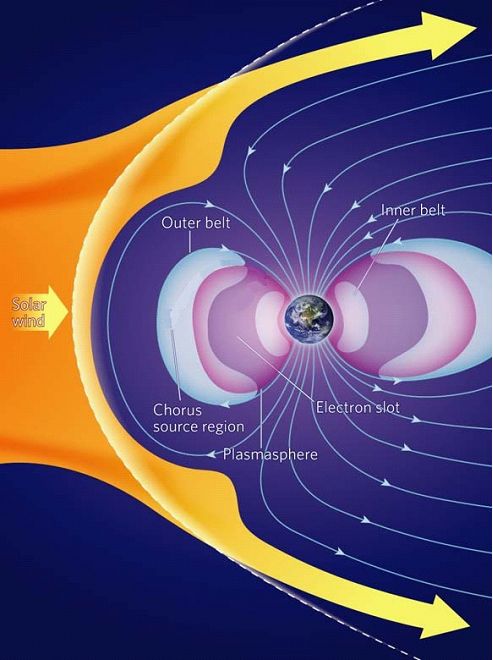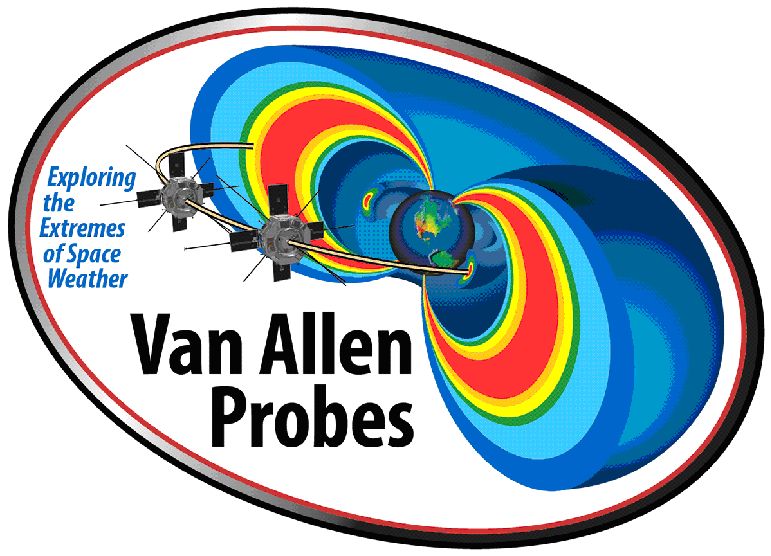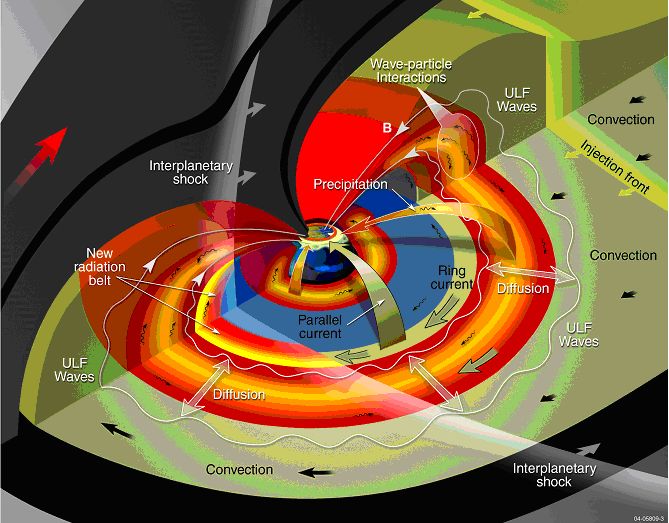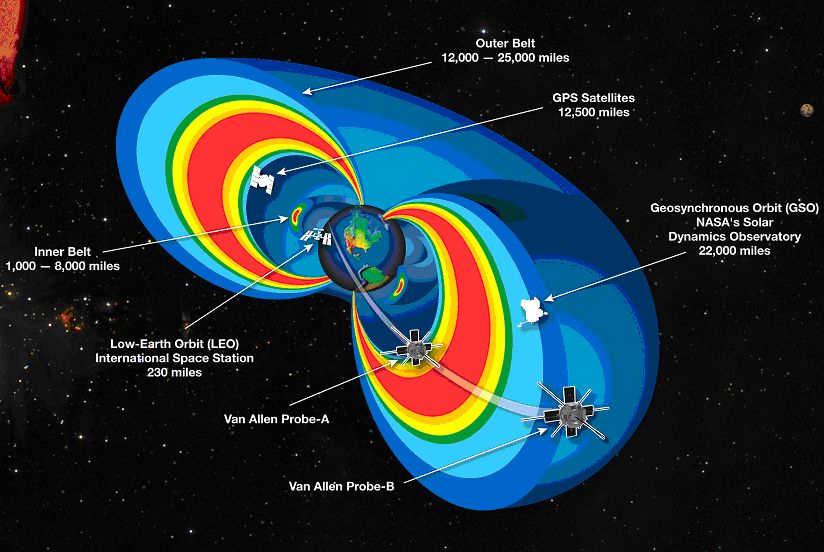Project SPeCIMEN
(Specification and Prediction of
the Coupled Inner-Magnetospheric Environment)
Background

Fig.1 Solar Wind, Magnetosphere, Radiation belts, Plasmasphere, Electron slot
The space around the Earth is filled with fast moving particles trapped in our magnetic field. These particles are principally electrons and protons, forming two "belts" separated by a "slot" region. The belts were initially discovered in 1958 by the first US satellite, Explorer I, and were named the "Van Allen radiation belts" in honour of their discoverer, James Van Allen of the University of Iowa. As most satellites spend their lives inside the radiation belts, they are directly affected by this environment. Earth-orbiting satellites can be damaged or even lost due to increased high-energy electron fluxes in the Earth's radiation belts. In particular, the outer radiation belt (located 3.5-8 Earth radii from the Earth's centre) is highly dynamic with fluxes changing by a factor as high as 1000 on timescales of hours to days. We know these changes are triggered from the Sun, and in particular by fluctuations in the solar wind, themselves reflecting conditions in the Sun's outer atmosphere.
Major research activity is being focused on the changing populations of very high energy electrons in the belts, termed "relativistic electrons" by physicists, but also known as "killer electrons" due to their effects. Killer electrons have such high energy (i.e., they are moving very rapidly) that they can penetrate the thin outer-shielding of most satellites, and impact spacecraft systems such that satellites may be damaged or even "killed". There are also associated radiation dangers for astronauts when they orbit the Earth. It is also interesting to consider what happens to these high energy electrons when they are lost into the Earth's atmosphere, how they influence the mixture of gases and possibly climate, which is part of the core–role of another SCOSTEP project.
While originally discovered in the dawn of the space-age, there are still significant questions surrounding the relativistic electrons in the radiation belts. Many scientists around the world are investigating how the flux of outer radiation belt electrons can change by so much, and so quickly. A current goal in space sciences is to understand the physics behind radiation belt electron flux dynamics to enable the development of predictive models. This requires physical understanding of the processes leading to the enhancements (increases) in radiation belt fluxes, as well as the loss drivers (i.e., what removes them).
In the SPeCIMEN project we are working towards the development of a predictive model. The scientific question can actually be stated simply: Can the state of the Earth's inner magnetosphere be specified and predicted to high accuracy, based on inputs from the sun and solar wind?

To help address this wider scientific area NASA launched the US$686 million 2-satellite Van Allen Probes in August 2012 to measure the trapped electron fluxes and make in-situ plasma wave observations from space. Other programs and nations have radiation belt-focused satellites in the pipeline, including Japan (ERG, December 2015), Russia (RESONANCE, December 2015) and the US Air Force (DSX launch in 2016). This is in addition to the existing missions such as THEMIS (NASA), CLUSTER (ESA), and Double Star (China), leading to a fleet of space-based experimental missions. At the same time there are dedicated balloon campaigns (e.g., BARREL in 2013 and 2014) and ground-based instrument networks being used to study radiation belt changes. There is a wealth of new observations.
Thus the SPeCIMEN project is well positioned to incorporate these data with the strong international efforts focused on theoretical models. SPeCIMEN provides an international framework for bringing these efforts together.
The Earth’s inner magnetosphere is an exceedingly complex, coupled system that is driven by fluctuations in the solar wind, ultimately reflecting conditions in the Sun’s corona. This inner magnetospheric environment is host to a variety of particle species (including electrons and heavy ions) that cover a broad range of energies from sub–eV to tens of MeV, and plasma waves that cover essentially the entire frequency spectrum. Incoming energy from the solar wind is processed through the system and results in a variety of effects such as the energisation of electrons and protons to MeV energies (i.e., the formation of the radiation belts), and the precipitation of particles into the dense upper atmosphere resulting in bright auroral displays, modifications to the distribution of ionospheric conductivities, and a slew of chemical reactions that propagate through the Earth’s atmosphere and may couple to surface climate. These effects also act as feedback processes to inner magnetospheric dynamics, throttling rates of reconnection or convection, modifying the pattern of the global electric field and hence wave excitation (which, in turn, affect the higher energy particles), and loading or unloading the system’s mass dynamics via substorms, flows, and related effects.
The inner magnetospheric system is not only the key link between the Sun/solar-wind input and atmospheric output, but also acts as the environment within which the vast majority of all Earth-orbiting spacecraft (i.e., commercial, scientific, or military) are immersed, and this environment is known to degrade or destroy such spacecraft through a variety of mechanisms.
SCIENTIFIC QUESTION: The scientific question can be stated simply: Can the state of the Earth’s inner magnetosphere be specified and predicted to high accuracy, based on inputs from the sun and solar wind?
AIM AND RELEVANCE: Given this context of fertile scientific ground, and a pressing societal need, we propose a science program that is aimed specifically at the specification and prediction of the inner magnetospheric environment. This includes the dynamics of the thermal (~eV), energetic (100’s of eV to 100’s of keV), and relativistic (~MeV) particle populations, the plasma wave environment (specifically focusing on the key waves that contribute to inner magnetospheric dynamics, such as ULF and VLF waves), and the system outputs in the form of precipitation flux into the Earth’s upper atmosphere, as a function of particle species, energy, location, and time.
DATASETS AND APPROACH: We believe that we are currently on the verge of answering the scientific question in the affirmative, but this cannot be done without a coordinated and sustained scientific effort that involves a large participation of the international scientific community. This is truly a “Manhattan type problem” and has never been attempted before on a grand scale. It is interdisciplinary and international, and will involve scientists in a variety of fields. While not requiring the financial backing at Manhattan project-levels, it will be only be solved by the combination of a wide range of experimental datasets, new experimental observations, and modelling techniques. We are fortunate that much of the puzzle pieces already exist in different parts of the world, such that a coordinated international programme will most likely bring successful closure.
We currently enjoy an unprecedented quantity of data that describes the inner magnetosphere, solar wind, Sun’s surface, and ionosphere. A recent example is the twin Van Allen Probes mission (formerly known as Radiation Belt Storm Probes) which has been launched in August 2012 and will operate for 2–4 years, collecting data on the particle and wave environment in the critical solar max and declining phase period beyond 2012. This dataset has spurred great interest in inner magnetospheric physics, and forms a complement to existing missions such as THEMIS, CLUSTER, Double Star, and context for upcoming missions such as MMS, DSX, BARREL, RESONANCE, ERG and others.
This is also an area where ground-based observatories can make significant contributions and enhance the understanding gained from the space-based missions. This provides opportunities for a wide range of international partners, and is thus not restricted to researchers from the primary space-faring countries. Indeed, some of the experimental techniques, such as observations of high-latitude VLF waves or mid- and high-latitude narrowband or riometer observations are comparatively cheap. As an example of strong scientific value from ground-based arrays, consider the THEMIS all-sky imager network which is able to do real-time imaging of the whistler-mode chorus wave field in space, through its signature pulsating auroral precipitation.
There are presently a range of models that describe inner magnetosphere dynamics, each of which has its own strengths and weaknesses. For instance, physics-based models (e.g., particle drift codes, or diffusion-based modeling) provide deep understanding but often cannot include all the relevant processes that drive dynamics. On the other hand, data-driven predictive models (e.g., data assimilative, or regressive models) can capture phenomena but do not necessarily provide insight into the physical processes involved.

